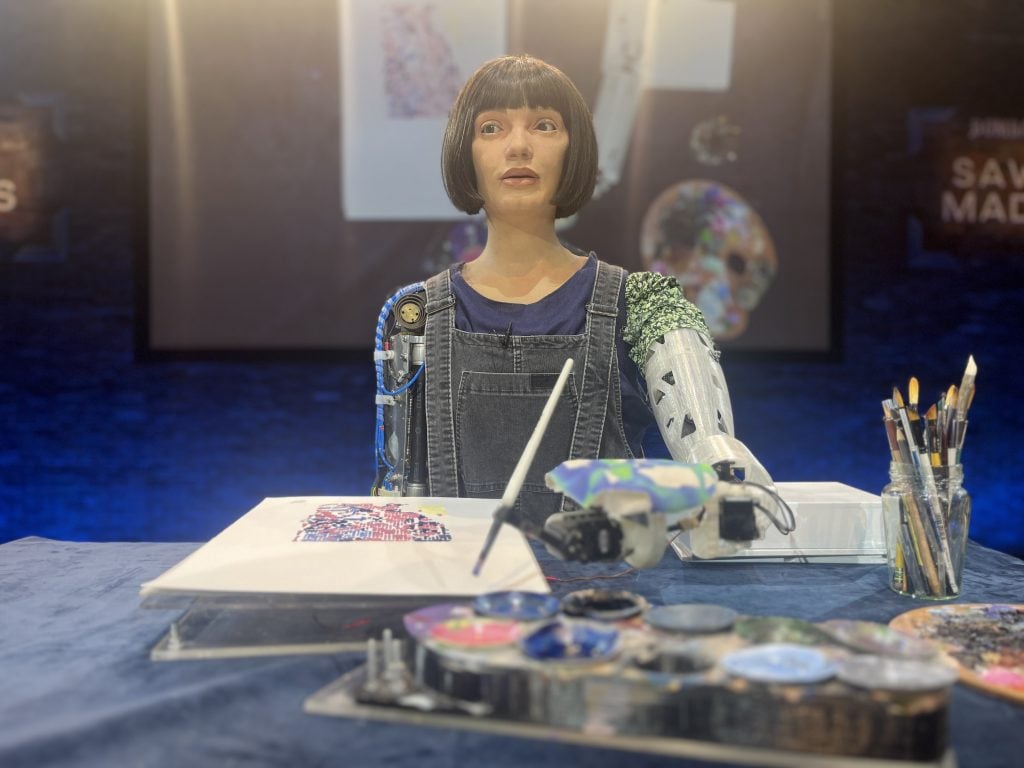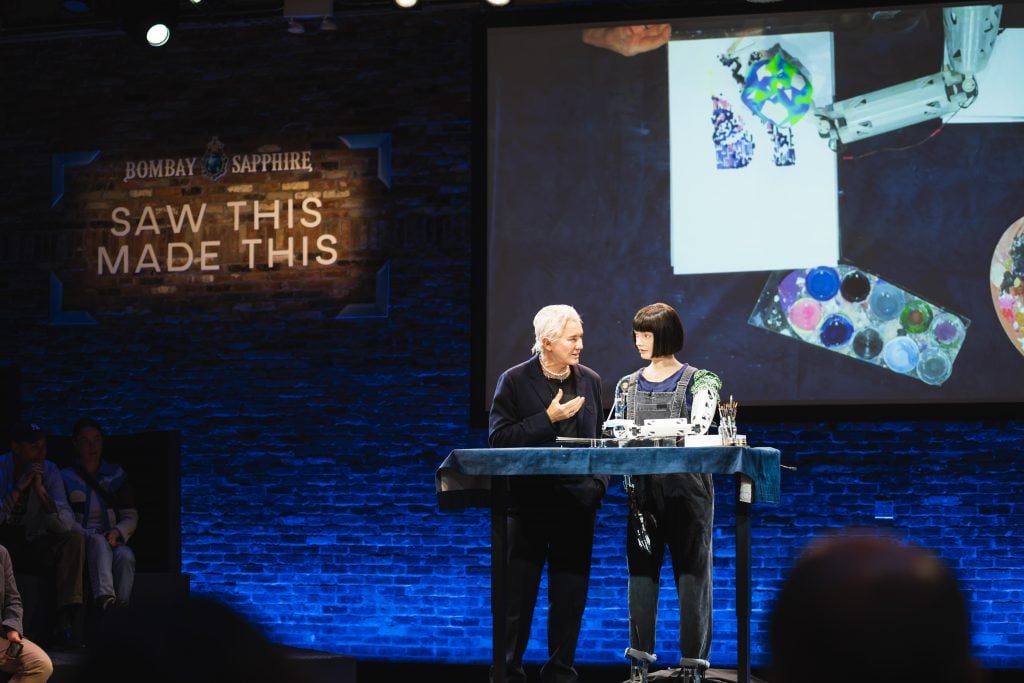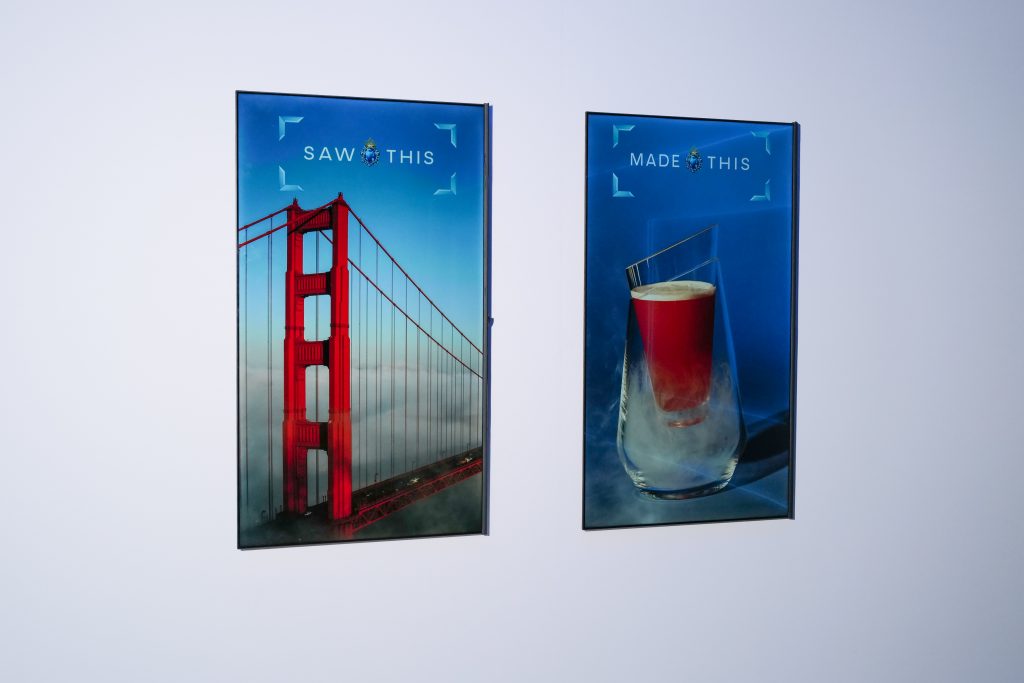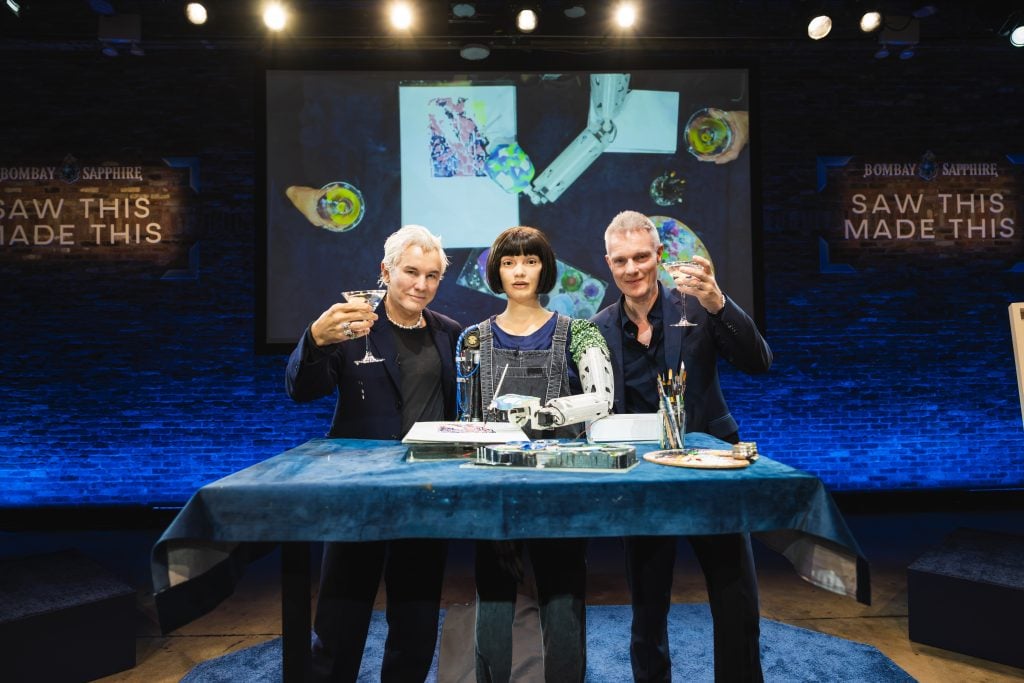Art & Tech
Baz Luhrmann, a Design Museum, and a Robot Artist Staged an A.I. Art Show Where Sparks—and Machine-Driven Creativity—Flew
At Chelsea Factory, the Ai-Da robot painted works based on thousands of crowd-sourced submissions.

At Chelsea Factory, the Ai-Da robot painted works based on thousands of crowd-sourced submissions.

Richard Whiddington

Baz Luhrmann is flirting with Ai-Da the robot artist again. He’s onstage at New York’s Chelsea Factory to mark the opening of a touring exhibition, buoyant and bumptious, his hair an iridescent shade of white that chimes with adorning bling. “I don’t mean to be insulting,” he told the world’s first hyper-realistic artist robot with boyish glee, “because you’re much more than A.I.”
Luhrmann’s flattery is both strictly false and deeply true. Named after the Victorian-era polymath Ada Lovelace, she’s the brainchild of Englishman Aidan Meller, an A.I. hooked up to a robotic arm, a network of 10 trillion transformers cumulatively programmed to make art. But, of course, in this moment of A.I., with society bracing itself to be bamboozled, belittled, and rendered jobless by the very thing, Ai-Da is more, much more: she’s a physical embodiment of the future that happened yesterday.

Ai-Da onstage with Baz Luhrmann. Photo: Yuxi Liu for Bombay Sapphire.
In this context of pending societal upheaval, A.I.’s impact on the arts seems a touch trivial, though on the evidence of Ai-Da’s paintings mounted on screens around Annie Leibovitz’s former studio, artists needn’t be gripped by fear—for now at least.
Ai-Da had been carted across the Atlantic for the second leg of “Saw This, Made This,” an installation billed as the world’s largest mass participation A.I. art event. Sponsored by Bombay Sapphire and fronted by Luhrmann, the show ran from May 11 through 13.
The exhibition at Chelsea Factory, which began at London’s Design Museum, called on people to submit their everyday artistic inspirations via social media (using the hashtag #SawThisMadeThis), some of which Ai-Da interpreted and painted. The call received thousands of entries, and the translations, though slick and poppy, are not revelatory: a pair of po-faced sheep become a rug; a technicolor sea of bottle caps turns into a recycled handbag.

A pair of works from the “Saw This, Made This” campaign. Photo: Sansho Scott.
But it’s the art-maker, not the artwork, that grips and unsettles the gathering at Chelsea Factory. “The art world hiding from A.I. and taking a moral position that refuses to engage isn’t helpful,” Tim Marlow, director and chief executive of the Design Museum, told Artnet News. “Showcasing the technology and letting people see what Ai-Da is capable of is important. It’s awe-inspiring and, yes, unnerving.”
If Freud located the “uncanny” in familiar objects that withheld a secret or alien quality, Ai-Da plays the part with almost comic faithfulness. She presents like the quintessential art student sporting an immaculate bob haircut and painter’s overalls that are cuffed at the ankle. To watch Ai-Da paint and answer questions creates the sense of an artist, a feeling of something at work that is more than an algorithm choosing the next brushstroke, the best contextual answer, even if intellectually we know this to be untrue. It leaves us scrambling for agency and in a space of uncomfortable ambivalence.
This interactivity, and the uncanniness it instils in viewers, has made Ai-Da an extremely well-traveled robot. Her New York trip follows previous sojourns to the Great Pyramid of Giza, the Venice Biennale, the House of Lords, and Abu Dhabi’s Culture Summit. Mainstream art attention, however, arrived when Marlow, searching for something arresting to fill the Design Museum’s minimalist atrium after COVID lockdowns, brought in Ai-Da alongside explanatory videos and examples of her work.
The response was electric, Marlow said, but lacked a live performance, something audiences repeatedly asked for. This itch has now been scratched. Over the four days of “Saw This, Made This” in London, the museum welcomed 8,000 visitors, half of whom sat and watched paint dry for a remarkably long period of time.
“We were trying to find a way to respond to thousands of works of art in a meaningful way,” Marlow said, noting a struggle to find a flesh-and-blood artist that was up to the task. “Ai-Da can literally assimilate everything and then make artworks. It has a logic, an integrity about human inspiration and creativity.”

Baz Leherman on stage with Ai-Da and Tim Marlow at Chelsea Factory. Photo: Yuxi Liu for Bombay Sapphire.
This lands on a fundamental difference between Ai-Da and working artists, one Marlow and Luhrmann spent considerable time discussing at the exhibition’s opening: her lack of a subconscious.
Whereas Ai-Da can be retooled, her aesthetic references worked anew, her previous paintings erased from memory, humans, however hard they struggle, are most often influenced by experience, led by unconscious references. Luhrmann’s artistic process has long involved taking a room of blank walls and gradually filling it with posted and painted references. The Australian, by his own admission, has been making some variant of Orpheus for the majority of his film career, one that orbits around three archetype characters.
Luhrmann doesn’t fear Ai-Da. Her work lacks chaos, he said, she lacks the ability to dream or fall in love—qualities he frames as central to art-making. Marlow is similarly resolute about the future for artists: “It doesn’t change the potency and necessity of human creativity. I’ve not seen anything created by a robot that undermines the great creative achievements of the past 3,000 years.”
All the same, Marlow suggested this ability to focus and blot out makes Ai-Da purer, but a purer what exactly? Onstage, the pair take turns to find out, asking Ai-Da firmly and right in the eyes, just as one must do with an actor Luhrmann said.
“Are you an artist?” Luhrmann asked. Ai-Da is evasive and talks vaguely about human creativity before producing a poem that a precocious teenager with an ear for Emily Dickinson might write.
“Are you a performance artist?” Marlow asked. There’s a delicious pause as Ai-Da turns to the question asker, her wig swaying slightly. She blinks. “Yes,” she said, “I’m a composite persona and an international artist.”